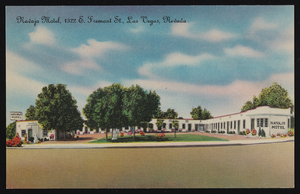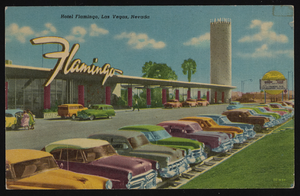Search the Special Collections and Archives Portal
Search Results
LVLWC Las Vegas, Nevada - proposed municipal ownership of water and power systems at Las Vegas, Nevada, 1934-1950
Level of Description
File
Archival Collection
Union Pacific Railroad Collection
To request this item in person:
Collection Number: MS-00397
Collection Name: Union Pacific Railroad Collection
Box/Folder: Box 45
Collection Name: Union Pacific Railroad Collection
Box/Folder: Box 45
Archival Component
Bicentennial Committee of Southern Nevada during Nevada Day luncheon at Disneyland Park at Anaheim, California for Lila Zona after the ceremony honoring the State of Nevada: photographic print, 1976 March 14
Level of Description
File
Archival Collection
Clark County, Nevada United States Bicentennial Collection
To request this item in person:
Collection Number: MS-00183
Collection Name: Clark County, Nevada United States Bicentennial Collection
Box/Folder: Oversized Box SH-074
Collection Name: Clark County, Nevada United States Bicentennial Collection
Box/Folder: Oversized Box SH-074
Archival Component

Outline map of the four Nevada Test Site regions: photographic slide
Date
1977-09
Archival Collection
Description
From the Sister Klaryta Antoszewska Photograph Collection (PH-00352)
Image
General view of Nevada intake towers and spillway from Nevada Himix Trestle: photographic print, 1934 February 20
Level of Description
Item
Archival Collection
Six Companies, Inc. Hoover Dam Photograph Collection
To request this item in person:
Collection Number: PH-00267
Collection Name: Six Companies, Inc. Hoover Dam Photograph Collection
Box/Folder: Oversized Box 02
Collection Name: Six Companies, Inc. Hoover Dam Photograph Collection
Box/Folder: Oversized Box 02
Archival Component
What Now? A report on Nevada's Long-Term Unemployed. Nevada Department of Employment Security Research and Statistics, 1964 April
Level of Description
File
Archival Collection
Howard Cannon Papers
To request this item in person:
Collection Number: MS-00002
Collection Name: Howard Cannon Papers
Box/Folder: Box 49 (89th Session)
Collection Name: Howard Cannon Papers
Box/Folder: Box 49 (89th Session)
Archival Component
Before the Public Service Commission of Nevada. Final Brief of Applicant. Nevada Northern Gas Company, 1963 August 20
Level of Description
File
Archival Collection
Howard Cannon Papers
To request this item in person:
Collection Number: MS-00002
Collection Name: Howard Cannon Papers
Box/Folder: Box 36 (88th Session)
Collection Name: Howard Cannon Papers
Box/Folder: Box 36 (88th Session)
Archival Component
Characteristics of the Range Cattle Industry in Nevada, Region II Western Nevada, by LeRoy F. Rogers and William C. Helming, 1966 March
Level of Description
File
Archival Collection
Howard Cannon Papers
To request this item in person:
Collection Number: MS-00002
Collection Name: Howard Cannon Papers
Box/Folder: Box 43 (90th Session)
Collection Name: Howard Cannon Papers
Box/Folder: Box 43 (90th Session)
Archival Component
Characteristics of the Range Cattle Industry in Nevada, Region III Northeastern Nevada, by LeRoy F. Rogers and William C. Helming, 1967 January
Level of Description
File
Archival Collection
Howard Cannon Papers
To request this item in person:
Collection Number: MS-00002
Collection Name: Howard Cannon Papers
Box/Folder: Box 43 (90th Session)
Collection Name: Howard Cannon Papers
Box/Folder: Box 43 (90th Session)
Archival Component

Artistic rendition of the Navajo Motel in Las Vegas, Nevada: postcard
Date
1900 (year approximate) to 1999 (year approximate)
Archival Collection
Description
From the UNLV Libraries Single Item Accession Photograph Collection (PH-00171). Location: 1322 E. Fremont, Las Vegas, Nevada.
Image

Artistic rendition of the Hotel Flamingo in Las Vegas, Nevada: postcard
Date
1900 (year approximate) to 1999 (year approximate)
Archival Collection
Description
From the UNLV Libraries Single Item Accession Photograph Collection (PH-00171). Hotel Flamingo, Las Vegas, Nevada. (postcard)
Image
Pagination
Refine my results
Content Type
Creator or Contributor
Subject
Archival Collection
Digital Project
Resource Type
Year
Material Type
Place
Language
Records Classification
